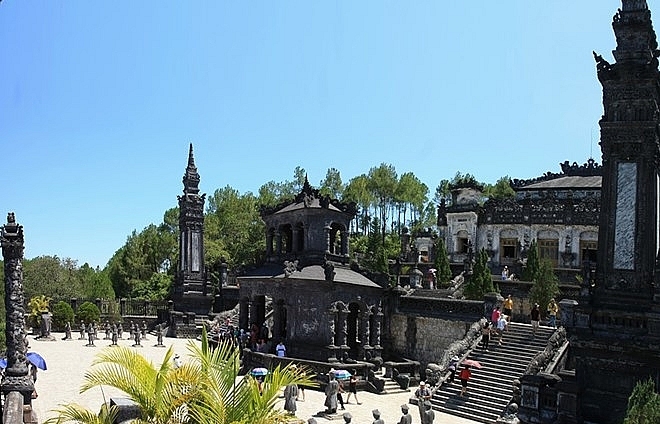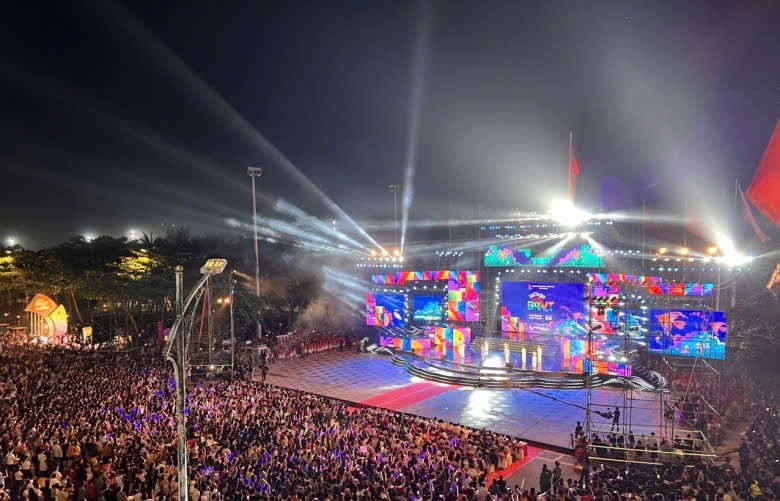Hue royal tombs’ historic charm
 |
| A fantastic view of Tu Duc Tomb |
And I bet none are disappointed with the ancient charms, vestiges of time and values of architecture and arts through ups and downs of history.
The Nguyen Dynasty (1802-1945) was the last of Vietnam’s Royal families. In all, there were 13 kings, however, due to various reasons, only seven had tombs, including kings Gia Long, Minh Mang, Thieu Tri, Tu Duc, Duc Duc, Dong Khanh and Khai Dinh. All tombs were constructed during the reign of the respective kings for which they were named. Each tomb was laid out with statues and monuments in perfect harmony with one another to form a poetically natural setting. The following elements were incorporated in all the tombs: walls, triple gate (Tam Quan gate), salutation court, stele house, temples, lakes and ponds, pavilions, gardens, and finally the tomb.
However, there are three tombs that are suggested for travelers - Minh Mang, Khai Dinh and Tu Duc.
Minh Mang Tomb was located 12km from Hue from 1840-1843 and consists of about 40 monuments of various sizes. The height of the Nguyen Dynasty was during the reign of King Minh Mang (1820-1840).
 |
| Tourists visit Minh Mang Tomb in Hue City |
Tu Duc Tomb was built between 1864-1867 and includes 50 monuments surrounded by a 1,500m wall. Born in 1829, King Tu Duc had the longest reign of all in the Nguyen Dynasty. He died in 1883 after 35 years on the throne. King Tu Duc was an expert in eastern philosophy, history, and literature. He left 4,000 verses and 600 proses, yet during his reign he failed to gain the respect of the citizens. Therefore being a romantic, the king immersed himself in the world he created at the site of his tomb. He ordered the construction of his tomb to be a fairyland with poetical features, making it a lifetime dream and a world for his eternal life after death.
So tourists will get lost in the romance with small wooden houses on the lake and green trees surroundings.
 |
| Visitors at Khai Dinh Tomb |
Khai Dinh Tomb’s construction began in 1920 and was completed in 1931. People often comment that this is the most beautiful of the three. King Khai Dinh (1885-1925) ruled Vietnam for 9 years when Western culture and influence began to seep into Vietnam. As a result, his tomb has many elements of Western architecture. The highlight of the tomb is concrete, its roof with slates and the gate imade of wrought iron. The builder made use of the lighting rod and electricity is used to light the place. Beyond these modern building materials and designs, the tomb had elements of eastern art mixed with western designs.
Throughout the interior of the tomb, colored glass and ceramic chips were used to form mosaics of oriental design. The ceilings were hand painted much like the ceilings of western churches, but the designs were of dragons and clouds.
What the stars mean:
★ Poor ★ ★ Promising ★★★ Good ★★★★ Very good ★★★★★ Exceptional
Related Contents
Latest News
More News
- Ba Ria-Vung Tau strengthens regional links to bolster tourism (November 04, 2024 | 10:00)
- Vietnam attracts growing interest from global travellers (October 28, 2024 | 17:59)
- Vietjet receives latest aircraft from Airbus in France (October 08, 2024 | 18:02)
- Telling travel stories through movies (October 08, 2024 | 14:00)
- South Korean tourists lead Vietnam’s tourism revival (October 08, 2024 | 11:49)
- Vietnam a golden land for golf tourism (October 08, 2024 | 11:41)
- Con Dao leads the way in circular tourism (October 08, 2024 | 08:00)
- Nestlé and VNAT announce new cooperation initiative (October 02, 2024 | 15:43)
- Hanoi recognises new city-level tourist areas (September 27, 2024 | 20:25)
- Hue to host 2025 National Tourism Year (September 19, 2024 | 15:13)




 Tag:
Tag:
















 Mobile Version
Mobile Version